Home theater projectors can revolutionize your entertainment time, offering a cinematic experience right in your living room. However, navigating through the vast array of options on the market to find the most suitable projector for your home theater can be quite daunting. This is further complicated by the rapid pace of technological advancements, which can make certain models seem obsolete in a short span of time.
With all that said, the number of new projectors hitting the market over the past few years has been in decline. This may be partially due to the COVID-19 pandemic of 2020, and also a result of the wide availability of large-sized and competitively priced flat panel displays coming to the fore and gaining the attention of consumers. For many, though, a front-projected image on a passive screen produces an unrivaled home theater experience.
We created this comprehensive guide to help simplify your decision-making process. It provides a thorough analysis of top-tier home theater projectors, taking into account various factors such as performance, features, and usability. With this guide, you’ll be well-equipped to choose the best home theater projector in your price range to ensure a truly immersive viewing experience.
Table of Contents
Best Budget Home Theater Projectors (under $2,000)
BenQ HT2050A
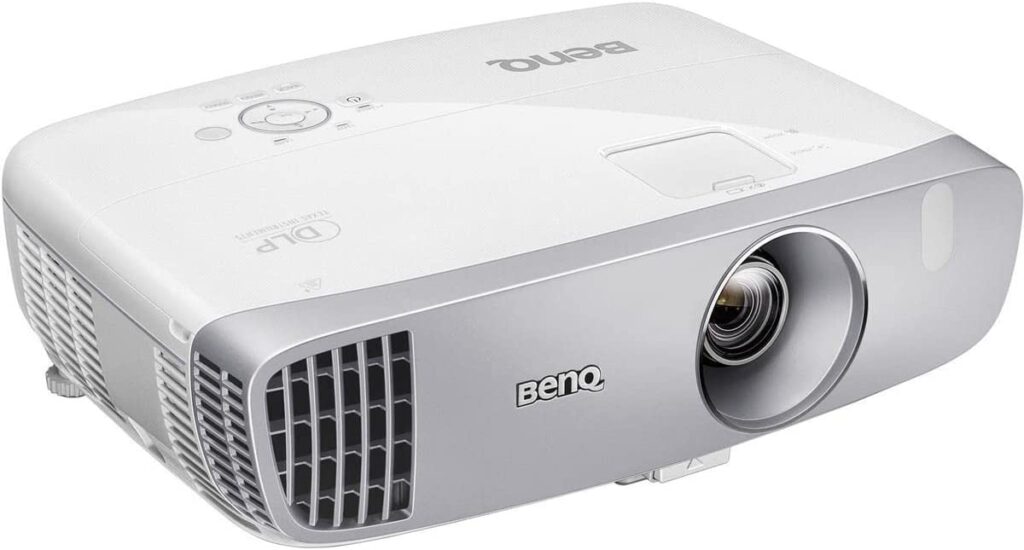
Although it’s a 2018 model, the DLP-based BenQ HT2050A still makes it onto our list as one of the best-in-class home theater projectors for those who are budget-conscious. Even though 4K models set the benchmark for many consumers these days, if you’re planning to save your hard-earned cash, it’s worth considering a 1080p model instead.
Many of the features that we used to pay big bucks for a few years ago are now commodity items on a large number of HD projectors. BenQ’s highly portable HT2050A can deliver a huge image from a short throw, has an onboard RGBRGB color wheel, and can produce 96% of REC.709 coverage.
Its high 2,200 lumens of brightness make it ideal for brighter or light-controlled environments, and both color output and black levels are exemplary for the category. Contrast is rated at 15,000:1 and lens shift extends to +10% in the vertical plane.
For gamers, the BenQ includes a fast input lag of 16.4 ms. And 3D fans can rejoice: DLP-Link glasses can be ordered if you can’t live without the tech.
The HT2050A should satisfy lamp life too, with 7,000 hours claimed in SmartEco mode. The projector is both portable and capable of delivering an excellent image for the price.
In addition to being a competent home theater beamer with excellent contrast, it can double as a TV or home entertainment device in rooms with ambient light, due to the bright lamp output.
Epson Home Cinema HC2350
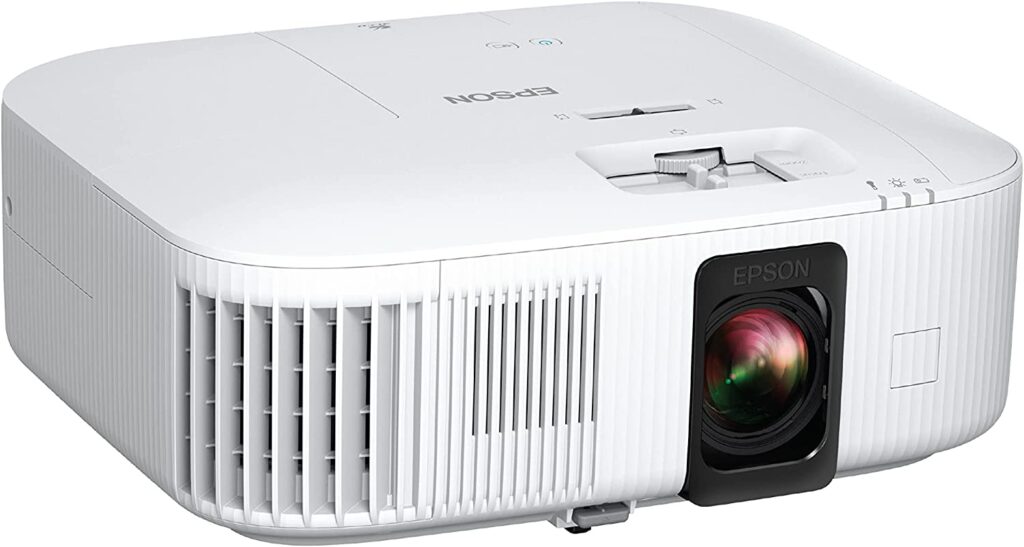
Epson earned its reputation from many years of producing high-quality optical technologies. Even though it has a legacy of producing commercial printing machines, it is probably better known now for its exceptional business and home theater projectors.
The compact Home Cinema HC2350 uses Epson’s tried and tested 3LCD technology to produce bright 4K images (with pixel-shifting). Boasting a 35,000:1 contrast ratio, along with Android TV and several streaming app options, the HC2350 could be an ideal choice for jumping into the world of owning a projector.
Brightness is rated at 2,800 lumens and, according to the manufacturer, the Epson can confidently illuminate any screen up to 500 inches diagonal. There is also a 10-watt built-in speaker, so it’s well-suited for bringing to the deck for a movie night.
Although the HC2350 doesn’t have any 3D capabilities, the projector is lightweight and manageable, making it easy to set up on a table or mount from a ceiling.
While you shouldn’t expect earth-shattering black levels from a projector in this price range, colors are nevertheless punchy and vibrant from both 4K and 1080p sources, with excellent skin tones and balanced performance right out of the box.
The HC2350 is also capable of producing a precise and detailed image. This full-featured and highly portable beamer carries two HDMI connections with HDCP 2.3, one of which supports an Android TV dongle, and the other ARC. The Epson Home Cinema HC2350 is a great way to step into the realm of 4K without damaging your credit rating.
BenQ CinePrime HT3550i
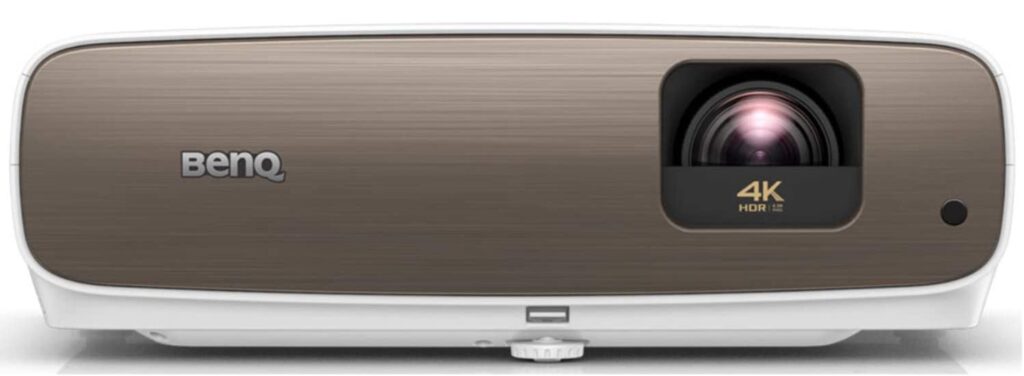
Last year, BenQ updated the hugely popular HT3550 beamer of 2019, which made it onto our last ‘best of’ list. The Taiwanese company hiked the brightness of the new HT3550i from 2,000 to 2,200 lumens and added the dynamic HDR10+ format (in addition to HDR10). A Local Contrast Enhancer also processes the image by analyzing 1,000 separate picture ‘blocks’ to improve the contrast ratio to 50,000:1, as compared to the HT3550’s 30,000:1.
All the while, the HT3550i can produce stunning colors and image detail, both of which are exemplary in this class. Although the HT3550i doesn’t share the same placement flexibility or improved contrast of the more advanced HT5550 (see below), you get away with much less cash outlay.
For those on a budget of less than $2,000, the finely styled HT3550i represents amazing value. On offer here is a claimed 95% of the P3 digital cinema color space (the same spec for professional digital cinemas) and 8.3m pixels on-screen. The beamer delivers a truly engaging picture in a light-controlled room. However, some may find the noise from the fans and color wheel distracting, which could be a critical consideration in a dedicated home theater.
And always remember that DLP technology can produce the dreaded ‘rainbow effect’ for some viewers. But, as we’ve said before, if you’re making that first transition from flat panel display to a projector, this could be a great place to start.
Best Mid-Price Home Theater Projectors (under $3,000)
Epson Home Cinema 5050UB 4K PRO-UHD
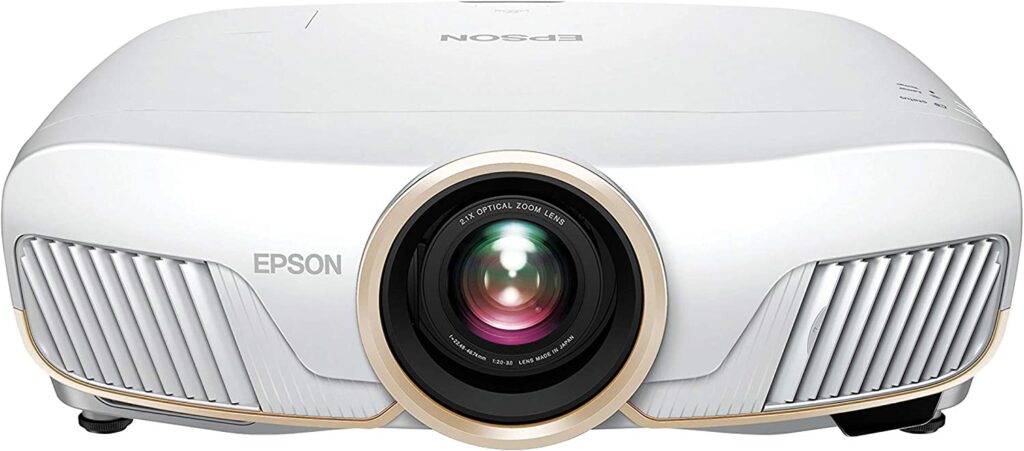
We reviewed the Epson Pro Cinema 6050UB here at HTF in 2019, which is essentially the same projector as its more affordable cousin, the white-bodied 5050UB we recommend here. While the beamer has in one sense been overtaken by the more recent laser-driven LS12000B (see below), the 5050UB is a phenomenal piece of kit for the price.
While it won’t blow your mind with JVC-like black levels and contrast, the 5050UB is capable of a wonderfully deep and nuanced image from both 1080p and 4K sources. But for under $3k (and now in some instances found closer to $2k), the blacks and shadow detail are unmatched in this price bracket and easily make it one of the best projectors for home theater at this price point.
HDR performance represents a significant improvement over earlier lines, too. But remember that this projector is a beast and has much larger dimensions than the former 5000/6000 series. Some of the reasons for the larger dimensions are the improved lamp cooling architecture and the motorized lens shift apparatus, both of which are much-needed features. And to that last point, the vertical and horizontal electronic lens shift is hugely generous, meaning there are many placement options for the 5050UB in a home environment.
To add to the mix of features and excellent picture quality, there are more picture-tweaking tools than a serious enthusiast could ever wish for. Five years on, Epson’s super-bright 2,600 lumens home theater beamer is still a force to be reckoned with.
BenQ CinePrime HT5550
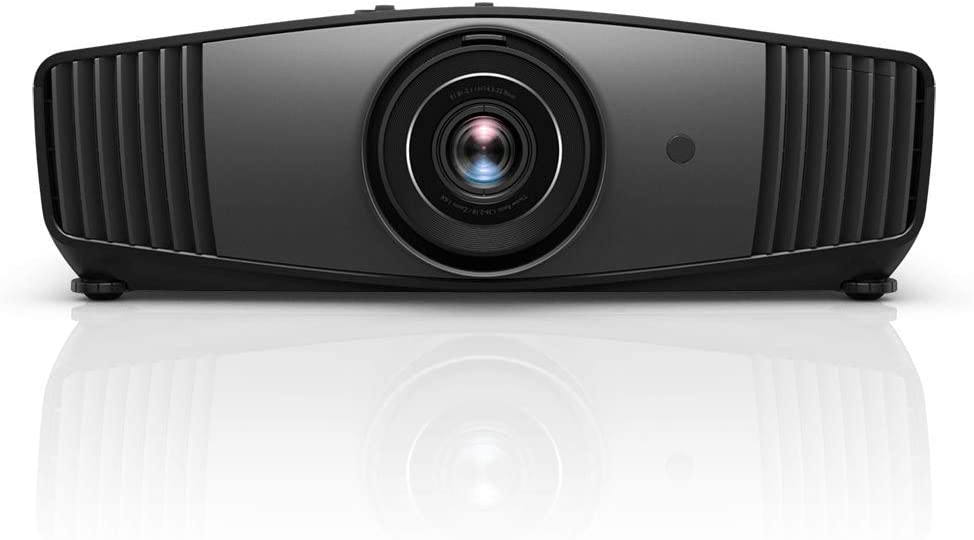
Although there is no clear price drop on BenQ’s HT5550 CinePrime projector four years on from its release, it still represents great value. It is yet another projector model that has not seen a revamp in a new product cycle.
The HT5550 offers a sharp carbon-gray design and sports an easily manageable weight if you are thinking of hanging it from a ceiling or placing it high on a shelf. Although built with some of the common components of the cheaper HT3550 (see above), the HT5550 has a significantly improved black level, claimed 100% of the DCI color gamut, and versatile but manual lens shifting.
DLP projectors are not for everybody, particularly those who are sensitive to the rainbow effect, but BenQ has pulled out all the stops with this sub-$3k HT5550. A four-times pixel-shifted image means 4K on-screen detail is exemplary, and if you decide to use the DCI-P3 gamut filter in high lamp mode on 4K HDR titles, you can draw out a beautiful palette of expanded colors.
Blacks are not the inkiest but are still commendable for this class and easily as good as its Epson 5050UB competitor. What you get on the upside with the HT5550 is a truly cinematic image and — due to its relatively small size — absolute ease of setup and operation. Read our full review here.
Optoma UHZ55
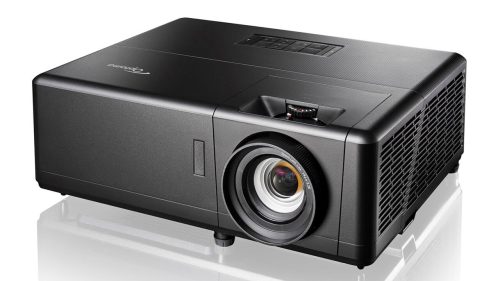
The black-housed Optoma UHZ55, like the white-colored UHZ50 in our previous list, is an excellent performer on movies but is also promoted as a gaming projector. The in-built light source uses laser technology as an illumination source, which is increasingly finding its way into lower price points. The UHZ55 promises an impressive 30,000 hours of laser life.
This 4K projector does, however, use a single-chip DLP display tech so, once again, be warned that rainbows may suddenly appear in your peripheral vision.
Optoma claims a dynamic contrast ratio of 2,500,000:1, with a +10% vertical lens shift and a generous throw ratio of 1.21:1 – 1.59:1. With 3,000 lumens of brightness, the UHZ55 has plenty of headroom for daylight viewing or sports broadcasts.
Gamers are rewarded with 4K/60p and a 16.7 ms lag time, reduced to only 4 ms with 1080p/240p content. Two 10-watt speakers and a portable 10.6 lb weight ensure the beamer’s pop-up cinema credentials, and there are two HDMI input ports and three USB connections.
Home cinema performance out of the box is excellent, although we always recommend that you get a projector in this price range calibrated professionally. No matter how good you might think your image looks in your man cave, every projector is subject to the vagaries of each specific environment.
The UHZ55’s colors pop in cinema mode and the picture is finely resolved on both HDR and SDR content. The projector is particularly adept at picking out shadow detail in problematic scenes. If you are a serious gamer, the performance is highly responsive. And perhaps the icing on the cake is 3D compatibility for those who can’t live without it.
Best High-End Home Theater Projectors ($5,000 and above)
Epson Pro Cinema LS12000B
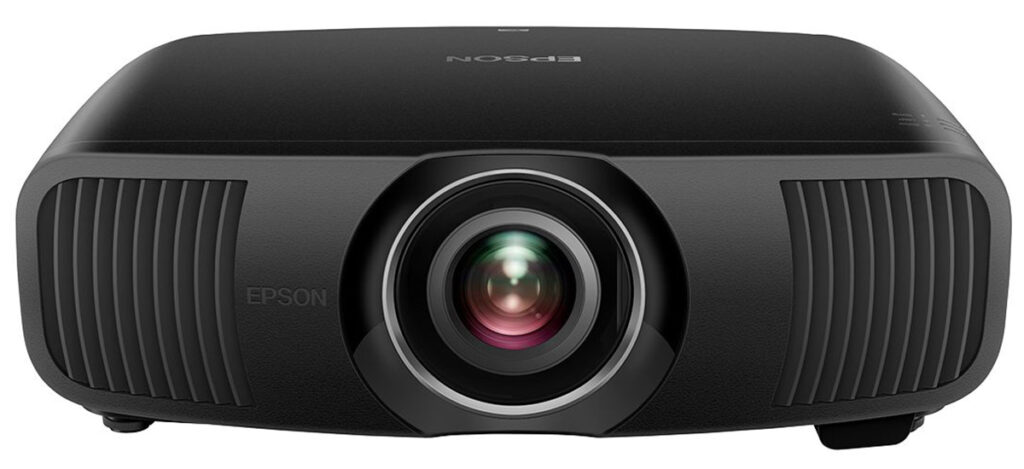
Although the Epson’s Pro Cinema LS12000B might look like it was replacing the earlier 6050UB, it feels like the company is placing this projector in a new category altogether. The new beamer is powered by a laser array light source. This is the first time the technology has been found at or around the sub-$5k price point. Whether Epson can import laser light engine technology into the magical $2k – $3k pricing sweet spot is yet to be seen.
The projector’s black housing has a more refined look about it than the curves of the former 6000 series. Epson imports many of the fine home theater-friendly specs from the former series, though.
As well as the versatile armory of programmable lens shift features, this tidy projector will deliver a bright 2,700 lumen image with improved pixel-shifting to produce more detailed 4K imagery. The high brightness of the LS12000B means that HDR content can really deliver on bright highlights while digging into shadow details and producing competent blacks. Note, too, that this latest home theater beamer from Epson can support dynamic HDR10+.
If you suffer from the rainbow effect of DLP devices, look no further than Epson in this price range, as there are none of those drawbacks with LCD designs. The LS12000B can produce beautifully saturated colors, excellent detail, and a truly cinematic image for the price.
Sony VPL-XW5000ES
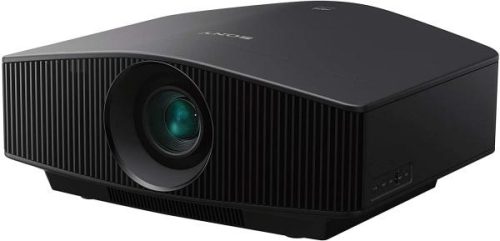
Sony continues to make its mark with a range of projectors designed for dedicated media rooms. Unlike the Epson LS12000B’s (above) pixel-shifted image, Sony achieves a native 4K (3840 x 2160) image from the VPL-XW5000ES’s onboard SXRD panel, driven in turn by a laser phosphor light source. There is no motorized lens shift and 3D support is noticeably dropped from this platform.
With that said, hovering below $6k for the kind of performance the 5000ES can offer is significant. While the Sony can muster 95% of the full DCI-P3 color space, its contrast measurements are better than those of the Epson LS12000B. The HDMI connections do not support the latest 2.1 specs, so keep that in mind if it’s critical for your setup and content. The shortfall in features here is clearly intended to keep the price down. Not surprisingly, the black level does not attain the high bar set by the JVCs.
What you do get with the Sony is an excellent out-of-box reference mode, spectacular imagery with well-saturated colors, and excellent motion performance. Some have suggested this projector package is the best value available in the entire home theater display market. It might be well worth exploring this model if your budget reaches this level.
JVC DLA-NZ7
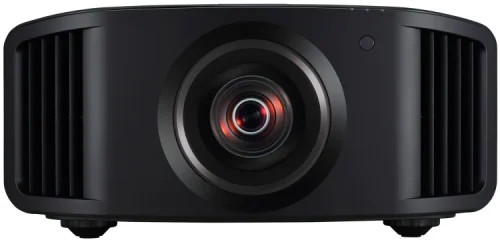
JVC once again shows they are masters of performance per dollar spent. Yes, $8k is a significant amount of money to drop on a beamer. But the company continues to redefine black levels and specs for the category.
The DLA-NZ7 supports 8K/60p and 8K/120p signals with JVC’s own e-shiftX technology to remap the images. The BLU-Escent laser light source and precision optics can achieve 2,200 ANSI lumens of output.
If you decide to jump up to the DLA-NZ8 at $16k, your only apparent spec sheet benefits will be a light output of 2,500 lumens and an improved contrast ratio. Native contrast from the NZ7 is cautiously rated at 40,000:1; JVC prefers not to oversell its upsides, simply because it doesn’t need to.
With 100% of the DCI-P3 color space available, optional 3D emitter and glasses accessories offered, and home-grown dynamic tone mapping, the projector is fully loaded for the most demanding home theaters.
The NZ7, like other JVC D-ILA beamers, is one of the larger projectors out there, but most people will hide it away in a hushbox or strapped to a ceiling. The list of helpful installation features is extensive, and there is a nice customized screen adjustment mode to optimize image performance for your screen size and room.
The DLA-NZ7 native 4K projector can produce luscious images. Contrast, detail, and black level from 4K and 1080p content are stunning. If image quality is more important than anything else in your home theater, then consider handing some of your budget over from the audio system towards a JVC. Many have taken the plunge, and we imagine few have regretted it.
Choosing the Best Home Theater Projector
Projectors come in all shapes and sizes. They can be optimized for any number of uses, such as education, business, professional cinema, advertising hoardings, rock concerts, or gaming. But only a select few target home cinema users. So, it’s useful to know which models will satisfy these specific requirements.
In general, home cinema projectors are designed to maximize colors and contrast. They should ideally also produce accurate, high-resolution images in dark or light-controlled environments.
With the help of more sophisticated light sources and high dynamic range (HDR) capabilities in home theater projectors, we are getting closer to replicating how movies look in professional auditoriums.
Although dynamic HDR systems like Dolby Vision have yet to find their way into affordable home theater projectors, we can still enjoy the benefits of HDR10 and even HDR10+ in some cases.
You don’t necessarily need to spend a lot of money to get great pictures on a fixed frame or drop-down screen. Make sure to do your research and buy the best projector to suit your needs and budget. You might, for example, prefer to use a portable projector to show a movie on a plain wall on an outdoor deck or in the living room. At the other end of the spectrum, you might choose a no-holds-barred reference experience in a dedicated home theater room.
The Best Home Theater Experience
Many home theater projectors cannot yet create the high brightness required to satisfactorily achieve HDR and deep contrast. OLED and other technologies found in flat panel TV displays today can do all those things along with superb black levels. These qualities are far more challenging to produce with front or UST (ultra short throw) projectors.
But a projected image delivers a totally different experience than that of a TV. When you fire up a beamer in the home onto a screen – even more so in a light-controlled or dedicated media room – you can almost smell the popcorn wafting over the seats.
For many enthusiasts, the transition from owning a flat panel TV display to a projector can be a life-changing experience.
We have already reviewed some of the products on our list, but Home Theater Forum consolidates its experience with all the 4K and 1080p projectors currently on the market to finalize these recommendations.
Prices and features for our recommended home theater projectors go in ascending order, so hopefully there will be a model to suit your budget. If there are any beamers you think we should have included, please add your thoughts in the comments below.
Martin, a seasoned journalist and AV expert, has written for several notable print magazines. He’s served in key roles at Lucasfilm’s THX Division, NEC’s digital cinema division, and has even consulted for DreamWorks. Despite his illustrious career, Martin remains rooted in his passion for cinema and acting, with notable appearances in several Spielberg films, Doctor Who, and Star Wars: The Empire Strikes Back. He currently resides in San Francisco.
Post Disclaimer
Some of our content may contain marketing links, which means we will receive a commission for purchases made via those links. In our editorial content, these affiliate links appear automatically, and our editorial teams are not influenced by our affiliate partnerships. We work with several providers (currently Skimlinks and Amazon) to manage our affiliate relationships. You can find out more about their services by visiting their sites.

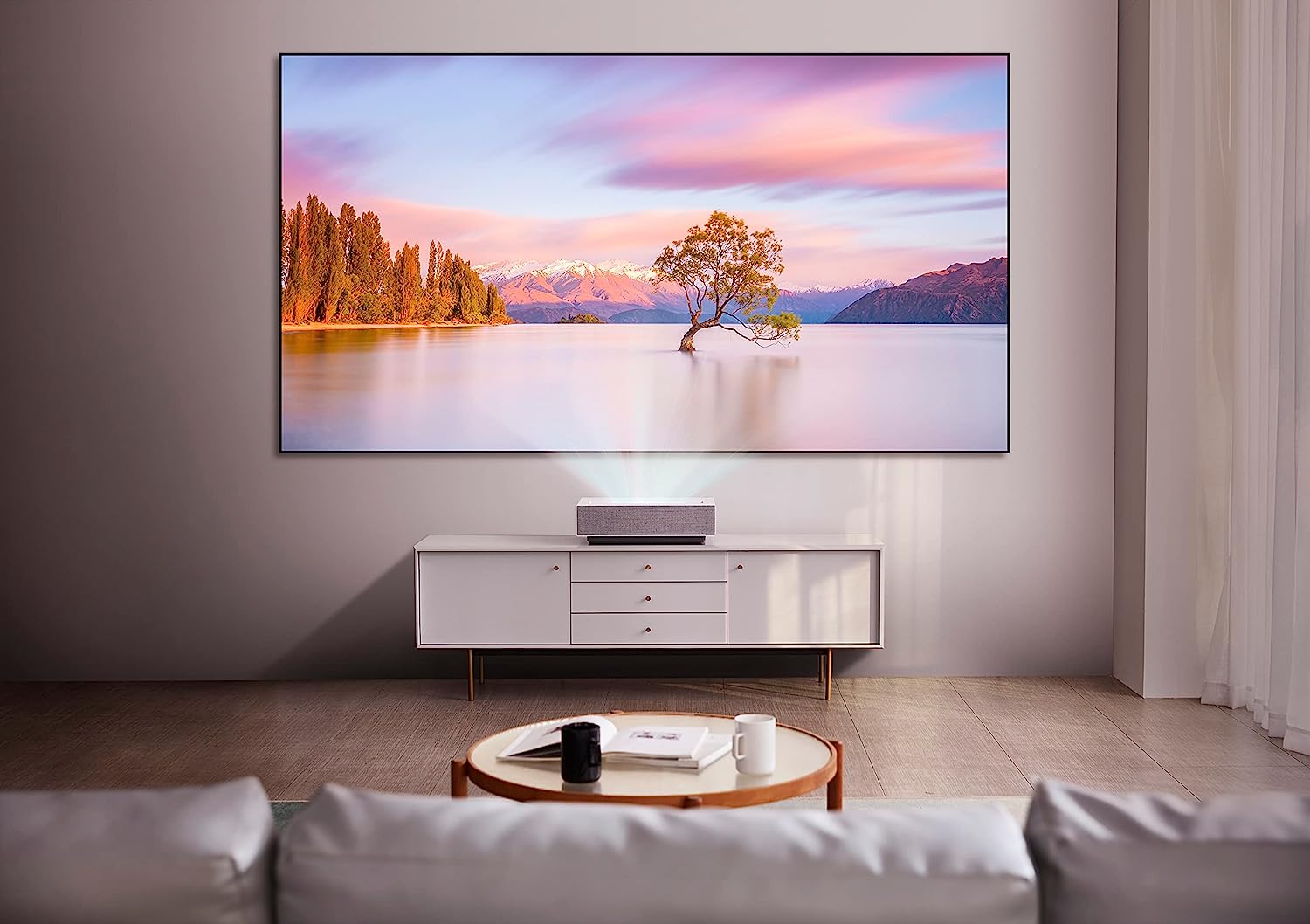

One Response
NO 3D for the Epson lS12000B